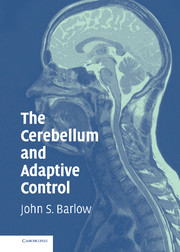Book contents
- Frontmatter
- Contents
- Preface
- Acknowledgments
- PART ONE ANATOMY AND PHYSIOLOGY OF THE CEREBELLAR SYSTEM
- PART TWO CEREBELLAR FUNCTIONS
- PART THREE MODELS AND THEORIES
- 13 Nonadaptive Models, Forerunners of Adaptive Models, and Earlier Adaptive Control Models
- 14 Neural Networks and Adaptive Control: Neural Network Models
- 15 Specific Features of Adaptive Controllers and Adaptive Signal Processors
- 16 Adaptive Control Models
- PART FOUR SUMMARY AND CONCLUSIONS
- APPENDIX A A Hybrid Analogue/Digital Multiplexer/Multiplier-Based Adaptive Signal Processor
- Author's Note
- Bibliography
- Index
13 - Nonadaptive Models, Forerunners of Adaptive Models, and Earlier Adaptive Control Models
Published online by Cambridge University Press: 28 October 2009
- Frontmatter
- Contents
- Preface
- Acknowledgments
- PART ONE ANATOMY AND PHYSIOLOGY OF THE CEREBELLAR SYSTEM
- PART TWO CEREBELLAR FUNCTIONS
- PART THREE MODELS AND THEORIES
- 13 Nonadaptive Models, Forerunners of Adaptive Models, and Earlier Adaptive Control Models
- 14 Neural Networks and Adaptive Control: Neural Network Models
- 15 Specific Features of Adaptive Controllers and Adaptive Signal Processors
- 16 Adaptive Control Models
- PART FOUR SUMMARY AND CONCLUSIONS
- APPENDIX A A Hybrid Analogue/Digital Multiplexer/Multiplier-Based Adaptive Signal Processor
- Author's Note
- Bibliography
- Index
Summary
In this chapter and in the following chapters, the terms “theory,” “hypothesis,” and “model” are used more or less interchangeably, although “theory” (or “hypothesis”) could imply a mental construct, whereas “model” could refer to an actual implementation, in terms of a mathematical model, a device, or on a computer (thus, a computer model).
This group of chapters on models and theories (this chapter and Chapters 14, 15, and 16) presents a limited survey, in roughly chronological order, of cerebellar theories that have been advanced since the 1960s. A comprehensive detailed, comparative, critical evaluation is not attempted, rather, an overview of the principal trends in modeling the cerebellum is the objective. In several instances, critiques of particular theories by proponents of other theories have been included. Some of the theories summarized in this chapter are only of historical interest, but other older theories were forerunners of adaptive control models that are considered further in Chapters 14 through 16. Discussions of cerebellar theories (primarily in its motor aspects) can also be found in, for example, Llinás (1981b), Ito (1984), Miall et al. (1993), Houk, Buckingham, and Barto (1996), and Thach (1998a, 1998b, 1998c).
Types of Theories
On the one hand, theories of the cerebellum can perhaps be categorized by how the cerebellum is organized, and on the other hand, by how it functions. In this survey, emphasis is on the latter group.
- Type
- Chapter
- Information
- The Cerebellum and Adaptive Control , pp. 169 - 203Publisher: Cambridge University PressPrint publication year: 2002



